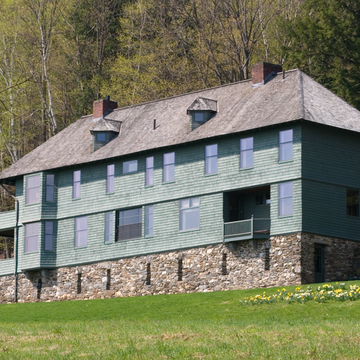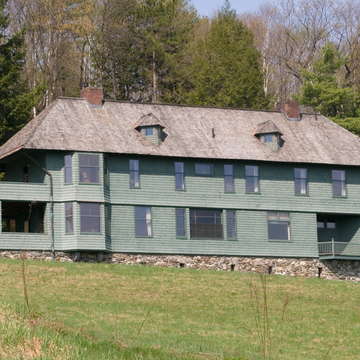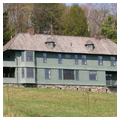One of the finest and best-preserved Shingle Style houses in Vermont is the residence that Rudyard Kipling named Naulakha (Hindi for “a thing of great value”). Kipling's association with the Balestier family of Brattleboro first brought him to Vermont. In London he had married Caroline Balestier, sister of American writer and publisher Wolcott Balestier, with whom he had collaborated on The Naulahka: A Story of West and East (1892). On a honeymoon visit to his in-laws, summer visitors who had become full-time residents, the reclusive writer was taken by the sense of peacefulness and solitude that had already begun to draw artists and writers to Vermont. He acquired eleven acres of family property across the Dummerston town line, with a wooded backdrop to the west and views of Mount Wantastiquet and Mount Monadnock to the east. Here, Kipling decided to build a house that merged the distinctive qualities of the Indian bungalow with those of the American Shingle Style. He worked closely with his architect, Marshall of New York City, who was a Balestier family friend.
The simple mass parallels the contours of its hill, two-and-a-half stories atop a basement of fieldstone salvaged from stone walls on the property. It is approached from the north on the western (uphill) side, which is given over almost entirely to circulation. The rooms open to the view through inset verandas and polygonal bay windows on the elevated, and thus more private, east front. Small angled dormers in the hipped slate roof light a top-floor billiard room. Kipling described the house as a ship, the kitchen and servants' quarters at the northerly stern, a two-story piazza that opened from his study and the master bedroom at the southerly prow. Beyond that a sunken formal garden led to the “long walk,” which terminated at a summerhouse of shingled pavilions joined by a Doric pergola. Besides its provision for privacy, the house was also personalized through interior relief sculpture by Kipling's father, who was a professor at the British School of Art in Lahore.
The Kiplings considered this their favorite home, but they occupied it for only a brief time. Their daughters were born here, and here, protected from intruders by his wife, Kipling wrote the Jungle Books (1894, 1895), Captains Courageous (1896), The Seven Seas (1896), and The Day's Work (1898). After a spat with his in-laws turned humiliatingly public, Kipling returned to England in 1896. The house and most of its contents passed to the Holbrook family, who, with the exception of small modifications (now largely removed) by the same architect, maintained it much as it was under the Kiplings. In 1992 the British-based Landmark Trust, a charitable foundation that restores and operates historic properties, acquired Naulakha as its first American building. Today the building is available for short-term rentals and is open for tours on annual public days. The house was designated a National Historic Landmark in 1993.


















